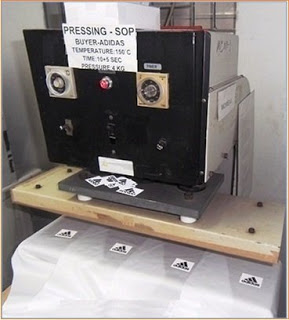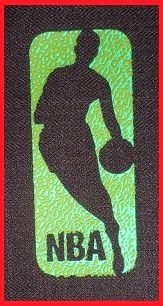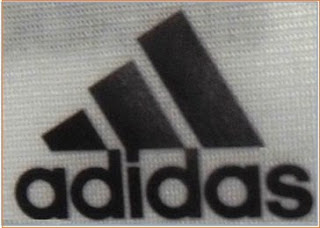Heat transfer print is another ornamental part of a garment. It has to be set on a particular garment zone by a transparent Logo-Print Film/Paper based on standard temperature, Time, and Pressure. Logo print film usually made of an artificial chemical compound and its object almost same as Screen Print. Generally, in garments sector for making garment, we depend on Natural Fiber. Due to the shortage for natural fiber demand of synthetic fiber increasing day by day in garments industry. Heat transfer mainly uses on synthetic fabric. In this situation, Textile/Garment manufacturers are feeling the importance and improvement of Heat Transfer Print. Heat transfer is a substitute form of screen printing and its purpose to minimize screen printing time as well as costing.
 To do the heat transfer operation, first operators need to reset the machine temperature, time, and pressure based on fabric nature to get the best performance or result. For this service, garment factory can follow the most modern, scientific machinery, lab test procedure, and inspection system. Most of the leading Buyer is using heat transfer print process for their effective product. In heat transfer operation QA department has to follow the several inspection methods. Those processes are mentioning below:
To do the heat transfer operation, first operators need to reset the machine temperature, time, and pressure based on fabric nature to get the best performance or result. For this service, garment factory can follow the most modern, scientific machinery, lab test procedure, and inspection system. Most of the leading Buyer is using heat transfer print process for their effective product. In heat transfer operation QA department has to follow the several inspection methods. Those processes are mentioning below:
(i) Collect the fabrics Swatch and Heat Transfer print film/paper.
(ii) Collect the BOM and logo instruction from Buyer/supplier
(iii) Brief Machine operator, QA, Cutting, Maintenance team & set the machine according to buyer or suppliers direction.
(iv) The machine temperature, time, pressure need to be reset to make the mock-up. Keep the device temperature, time, pressure record.
(B) Lab Testing Procedure:
(i) There are three kinds of Lab Test for Heat transfer print.
*PEELS OFF
*STORAGE TEST
*COLOR BLEEDING (Color Fastness) TEST.
(ii) Does lab test daily minimum1 PC/Color/Logo/Style by the following procedure?
* Generally Lab test standard level 5 cycles for PANEL & 3 cycles for garments.
(iii) Must need to keep lab test record and maintain the inspection log-book
(iv) Prepare daily inspection report and dispatch to concern section.
(C) Mock-up processing & analysis:
(i) If found any instruction from supplier/buyer, kindly follow it first, if the result is passed then proceed to production.
(ii) If not found any right information from supplier/buyer, then apply the basic idea to set the machine and record the Time, Temperature, and pressure accurately.
(iii) If visually, accept then sent for a lab test. If the lab result is:
Pass—then proceed to production.
Fail—then again do mock-up by readjusting the machine temp, time, pressure etc. then resubmits those mock-up for a lab test (Until getting the Pass results).
(D) Pre- Bulk Caution:
(i) Any failed issue Re-heat/Re-test or find out the reason and stop the production till getting the pass result.
(ii) Daily cleaning the machine and try to set one M/C for an individual LOGO.
(iii) Use the Rubber/Washer as per LOGO size and White knit fabrics for avoiding the shining mark.
(E) Bulk Production. Processing and analysis:
(i) Heat transfer machine and inspection table need to set in a restricted area for smooth production.
(ii) Production people need to check the Logo placement, design, and fabric item, color combination etc. randomly before start.
(iii) Submit mock up two times daily for lab test and keep a record.
(iv) Maintain the daily inspection LOG BOOK and Inspection Summary.
So finally, we can say Heat transfer is a process of transferring an image to a substrate by applying heat and pressure. That means a design is printed on paper with special dyes and transferred to a product by application of heat and pressure. Specific temperatures and dwell times change a dye from a solid to a gaseous state and back to a solid form on the product. Heat transfer prints are
available in stretch, flock, puff, reflective and foil design.
 To do the heat transfer operation, first operators need to reset the machine temperature, time, and pressure based on fabric nature to get the best performance or result. For this service, garment factory can follow the most modern, scientific machinery, lab test procedure, and inspection system. Most of the leading Buyer is using heat transfer print process for their effective product. In heat transfer operation QA department has to follow the several inspection methods. Those processes are mentioning below:
To do the heat transfer operation, first operators need to reset the machine temperature, time, and pressure based on fabric nature to get the best performance or result. For this service, garment factory can follow the most modern, scientific machinery, lab test procedure, and inspection system. Most of the leading Buyer is using heat transfer print process for their effective product. In heat transfer operation QA department has to follow the several inspection methods. Those processes are mentioning below:


Leave a Reply
You must be logged in to post a comment.